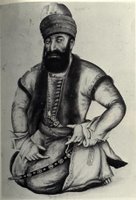The King Who Refused His Title

Born in Shiraz in 1705, Karim Khan was the founder of Zand dynasty in Iran. Of humble tribal origin, Karim Khan became one of the generals of his predecessor, Nader Shah. In the chaotic aftermath of Nader’s assassination in 1747, Karim Khan became a major contender for power but was challenged by several adversaries. In order to add legitimacy to his claim, he in 1757 placed on the throne the infant Shah Ismail III, the grandson of the last official Safavid king. Ismail was a figurehead king, real power being vested in Karim Khan, who never claimed the title of shahanshah (king of kings) but used that of vakil (regent). He believed that the Shah was just an ordinary person who lived among ordinary people. All the titles & razzmatazz meant nothing to him. He was deeply religious, & held the officials responsible for all the shortcomings in the society.
By 1760 Karim Khan had defeated all his rivals and controlled all of Iran except Khorasan, in the northeast, which was ruled by Shahrokh, the blind grandson of Nader Shah. During Karim Khan's rule Iran recovered from the devastation of 40 years of war. He made Shiraz his capital, constructing many fine buildings. Moreover, he reorganized the fiscal system of the kingdom, removing some of the heavy burdens of taxation from the agricultural classes. An active patron of the arts, he attracted many scholars and poets to his capital.
Karim Khan also opened Iran to foreign influence by allowing the English East India Company to establish a trading post in Bushehr, the Persian Gulf port (although this was later proved to be a bad mistake). In advancing his policy of developing trade, in 1775-76 he attacked and captured Basra, the Ottoman port at the mouth of the Persian Gulf, which had diverted much of the trade with India away from Iranian ports. The civil war that followed Karim Khan's death ended only with the final establishment of the Qajar dynasty in 1796. Karim Khan was a brave leader who restored peace to the kingdom after the strife following the collapse of the Safavid dynasty & the chaos towards the end of Afsharis' rule. He died in the year 1779 & at the age of 74. At the time of his power he built many of the famous monuments in Shiraz. Some of the most enchanting ones are Arge Karimkhan, Karmikhan Bath ( hammame vakil) and Vakil bazzar ( Bazzare vakil). To see the pictures I took last summer click on the name of the locations!
Picture of Karim Khan:
http://www.qajarpages.org/karimkhan.jpg
http://www.art-arena.com/Iran/karimkhan.jpg
Pictures of Arge Karim Khan in Shiraz:
http://www.yu.ac.ir/old/kesh/Shiraz/argpics.html
Pictures of Vakil Bath (hammame vakil):
http://www.hammam-vakil.com/gallery.html
http://www.art-arena.com/Iran/zandpbath.jpg
Pictures of Vakil Bazar:
http://www.art-arena.com/Iran/zandbazaar.jpg
http://www.iranonline.com/iran/Fars/images/bazaar-vakil.JPG
Pictures of Masjed Vakil:
http://www.parspage.com/history/shirazmasjed.gif

